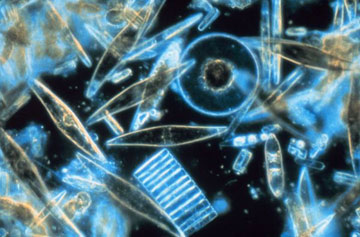It’s a jungle out there. Life in the oceans is a constant struggle for survival, with bigger critters eating the smaller ones. It’s not just a struggle of the sharks and fish and crabs, though. It’s a struggle that plays out in every cubic inch of seawater -- enough to make one good mouthful.
 A sample of seawater containing phytoplankton. Credit: Wikipedia
A sample of seawater containing phytoplankton. Credit: WikipediaSeawater isn’t all that appetizing anyway. About three and a half percent of it consists of the dissolved minerals that make it taste salty. And we all know from Hollywood movies that you don’t want to drink the stuff -- at least not in big gulps. The minerals build up in your system, causing kidney failure and other problems.
But every mouthful of seawater contains much more than just water and salts. It also contains millions of living organisms.
Most of them are bacteria. On average, a mouthful of seawater contains more than 10 million individual bacteria, representing perhaps a thousand species.
But there’s no lack of larger organisms. That same mouthful holds more than 10,000 phytoplankton -- simple plants that float in the upper layers of the oceans. Many of them are like little tanks, because they’re surrounded by glassy shells. And you’ll also find hundreds of tiny animals known as zooplankton. Most are microscopic, but there are a few larger ones, like fish eggs or larvae.
Most of these critters are harmless, so if you happen to swallow a mouthful of water while you’re splashing around, don’t worry about it. Just think of it as some extra carbs and protein -- or a mouthful of jungle.

